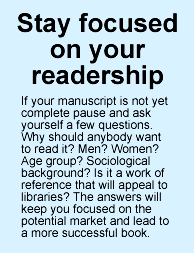a business plan
credit control
the law of libel
stamina
first-class time management

Glancing through the list above you may be forgiven if your eyes glaze over words like business plan, book-keeping and typography.
And you may find the list a total turn-off.
Take heart. Few people have all the skills and what you lack you can learn or buy in. Think of these skills like a metered tap. You can turn on the tap and take as much as you like.
Just remember it has to be paid for. Three of our readers featured in this article did just that.
Before you go into self-publishing you must have a good and substantial reason. Frequently, the fact that an established publisher does not want to produce your book is insufficient.
If it is not good enough for Hodder or Random House, Kogan Page or Piatkus, why should it be worth a year of your time and money in addition to the labour of producing the manuscript?
A bad book, or one about a subject that interests few people, will still be a bad and uninteresting book even if you publish it yourself, Morroco-bound and printed on parchment.
Before you collapse in despair pour out a glass of Chablis, make a wholesome vegetarian snack, and read on.
Let's assume you believe in your book. You can see 3,000 sales as an achievable goal and you are determined to show'em:whoever'em might be. We are talking about a book published on paper between covers, either soft or hard, which looks like a book, smells like a book and reads like a book.
Forget about e publishing and the internet for the moment. That has a part to play in the marketing but little in the initial stages apart from its use as research tool.
We are starting from the premise that the manuscript is finished. Here is where the editing begins. There is no friendly agent, no publisher's editor to lick it into shape. Any tautology, poor grammar, shoddy spelling, non sequiturs, libels, gaps, illustrations to research, captions, acknowledgements to make, or permission to quote from other works must be dealt with by you.
You are wicket keeper and long stop. You have to be the most critical and pernickety editor as possible. Check every fact about which you are not certain. If you are not sure whether there are two effs in sophisticated, or the rate of fire of a 9mm. Browning automatic, or who was the last Hanoverian King, it's your job to find out. One careless mistake in your book may devalue pages of excellent material.
When eager readers buy your book there is an unspoken contract: their time and money in return for a book that either entertains or informs them. Preferably both. It's time for a plus point or two to keep you going. Remember that you are going to receive a much bigger percentage of the cover price then if you were dependent on Random House royalties and the shelf life of your book is as long as you care to make it. Books from main-line publishers last on average four months in the book shops if they are lucky. You can be selling your book for years.
Now is a good time to revise your original plan. Critical path planing in publishing is as important as it is in building.
Check the facts, grammar, punctuation and proof-read it. You can acquire these skills or buy them in. Let us assume that your book is non fiction and the manuscript ready for press on a disk.
MAKE A COPY ON ANOTHER DISC AND PUT THE COPY IN A SEPARATE BUILDING WITH A SPARE PRINT-OUT AND PHOTOCOPY ELSEWHERE.
In publishing and dealing with printers always assume if something can go wrong it will go wrong.
T.E.Lawrence lost the first manuscript of Seven Pillars of Wisdom on a train to Waterloo station and re-wrote the entire story in a matter of days. Most of us are not that clever and would dissolve into tears, but T.E. was made of sterner stuff.
Now you are ready to talk to a printer. The chances are that you will deal with a relatively new technique called digital printing. This allows you to print far fewer copies at a unit cost that would have been unthinkable a few years ago. Many offset printers have installed digital equipment and they will decide which is the most economic to use. Do reveal that you are seeking several quotations.
You need at least five quotations and each printer must be given the same specification so that you can compare like with like.
To quote, the printer will need the following details:
- number of pages
- page size
- run (the number to print)
- whether there is to be a four-colour book jacket
- number of illustrations if any
- whether you will supply scans
- whether they will be in colour
- type of paper required
- type of binding
- turn around time from receipt of manuscript to delivery of book
- how the manuscript is to be submitted (on a disc and what format)
- the number of words and characters

Run-on price from 3,000, the run-back price (if you change your mind on the quantity).
Reprint price if you sell out and feel the market would stand a further 1,000 or so.
Remember that the reprint price will not be the same as the re-on price.
You can also ask his price for packaging if he takes on the warehousing.
Check how much of the task your printer will "put out to trade". Frequently smaller printers will put out the binding and typesetting, if any. This is not necessarily a bad thing but it does mean that you are greater risk from delays. Don't let him build up an excuse, "I've been let down by the binders".
In any production schedule agreed - in writing - with the printer, building secretly for yourself at least 14 days as contingency for delays. Remember you will have to keep to the schedule. If you are two days late with the manuscript it does not mean that this will be reflected by a two-day delay in delivery. If you miss a booked machine slot that delay could escalate to month.
Now you may not know your Picas from your Breviers, octovo from quarto, coated stock from Basildon Bond or Bodoni Ultra from Century School Book... That does not matter. Find a book of standard size that you like. You are almost certain to read something like this in early pages:
Printed by Bloggs in Newport, set in Caledonia 10 on 11pt etc. Or it may be in TIMES 11 on 13pt, Garamond 12 on 13pt or something similar. Caledonia, Times and Garamond type faces.
If you find such a typeface in a modern book and like it, choose it. Please, please do not select a fancy type because it is different. You want your book to look like a book, not like a catalogue for the Tate Gallery or a Festival Hall programme.
Elegant, unusual type faces in the hands of experienced typographers and designers are a delight but seldom work in chunks on a normal page.
Do not worry if you lack any particular type face on your PC or Apple Mac it is a matter of moments and little cost for the printer to format your book and select a suitable typeface.
Count the number of words on a page of the book you like, divide that into the number of words in your manuscript, add the number of pages you think are necessary for illustrations and that will give you a rough idea of the pages in your finished book. You will find that it is best to work in multiples of eights or sixteens. You will need an additional eight or so for the forward, contents, fly leaf, dedication, index and acknowledgements.

 Glancing through the list above you may be forgiven if your eyes glaze over words like business plan, book-keeping and typography.
Glancing through the list above you may be forgiven if your eyes glaze over words like business plan, book-keeping and typography. Run-on price from 3,000, the run-back price (if you change your mind on the quantity).
Run-on price from 3,000, the run-back price (if you change your mind on the quantity). Armed with the principle cost you are ready to draw up a business plan. Write down a cost for everything - even the tiny chores you do yourself like phone calls to libraries, travel to sources, lunch with contacts, postage, photocopying, stationery and an hourly rate for the writing. What are you worth per hour? A cleaner gets �5. A lawyer might charge �300.
Armed with the principle cost you are ready to draw up a business plan. Write down a cost for everything - even the tiny chores you do yourself like phone calls to libraries, travel to sources, lunch with contacts, postage, photocopying, stationery and an hourly rate for the writing. What are you worth per hour? A cleaner gets �5. A lawyer might charge �300. Austen Bliss and Owen Smith, who have written the definitive guide to the distinctive wines of Chablis, are newcomers to publishing. They have long been friends, sharing a love of fine wine as a hobby and tasting various vintages all over the world.
Austen Bliss and Owen Smith, who have written the definitive guide to the distinctive wines of Chablis, are newcomers to publishing. They have long been friends, sharing a love of fine wine as a hobby and tasting various vintages all over the world.